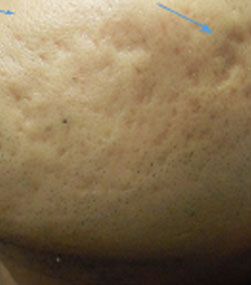



Grade I – Macule – erythematous / hyper pigmented/ hypopigmented flat mark
Grade II – Mild rolling, small, soft papular scar
Grade III – Significant rolling, shallow boxcar, and mild- moderate papular / hypertrophic scar
Grade IV – Punched out, atrophic deep boxcar, ice pick, bridges, tunnels, dystrophic, hypertrophic, keloidal scar
Scars can be atrophic or hypertrophic.
Craters – These are deep scars whose width is equal to or greater than their depth.
Pits – These are scars whose width is less than depth.
Ice pick scars – These are rocket shaped /V shaped scar where base of the rocket is on the skin surface and tip lies at a depth
Box scars – These are deep U shaped scars
Rolled scars – These are W shaped scars.
These are raised scars associated with excessive fibrous tissue formation.
Dermaroller – This is a special instrument, with micro needles, which is used to fill up superficial as well as deep acne scars. The procedure will even out the skin texture through collagen stimulation.
Dermastamp – This is an instrument, which has five small micro needles in it to treat localized depressed scars.
Laser – Fractional Resurfacing is a new technique where microscopic thermal wounds within the selected target area are created producing tiny dot, or grid-like treated areas on the skin), leaving the other zones within it perfectly intact. This causes fractional damage through the heat created in the skin. This allows the skin to heal much faster with minimal discomfort and less downtime as the healthy untreated tissue surrounding the treated zones helps to fill in the damaged area with new cells. Recovery occurs in 5-7 days.
There are different types of fractionated lasers:
Light Systems – IPL acts by heating the dermis and stimulating new collagen formation. It is useful for treating red post acne scars.
Chemical Peels – 70% Glycolic Acid peels can be done to treat hyper pigmented, red and shallow scars. TCA peeling can be done for hyper pigmented and deep-pitted scars. Spot TCA peeling is a very good technique for isolated ice pick scars.
Microdermabrasion – A fine stream of aluminum oxide crystals is used to exfoliate the skin’s upper layers. The intensity of exfoliation can be varied to suit an individual’s skin type from light exfoliation to deeper resurfacing. This procedure stimulates collagen production and renews skin elasticity; thereby, enhancing the skin tone and resilience. This treatment is useful for treating superficial acne scars.
Fillers – these can be used to raise sunken scars to the level of surrounding skin. Hyaluronic acid is a very safe injectable material that is used to restore structure and volume to the skin. It is a good and safe option. The effects are usually temporary lasting 6- 12 months.
Autologus fat transfer – Autologous fat transfer, is a procedure in which an individual’s own body fat is removed from the abdominal area, emulsified and put in the areas of volume loss for e.g. sunken or emaciated areas of the face.
Radio surgery – In this procedure, radio waves are used in ablative mode, to ablate the unwanted layers of the skin and flatten out the edges of scars and to promote collagen remodeling thereby filling up deep irregular scars.
Steroid injections – Intralesional Steroid Injections like Triamcinolone Acetonide 10mg-40mg may be used for raised keloidal and hypertrophic scars. These injections help to soften thick stubborn fibrous tissue.
Subcision – This involves subcutaneous sectioning of dermal adhesions with a sharp needle thereby lifting the scars. This technique is useful for very deep-pitted scars. ice pick scars, boxcar scars and rolled scars
A-7 MIG behind axis bank, near sanjeevni nursing home, AB Rd, Indore, Madhya Pradesh 452001
Ph. : +91 9826014164
Email : [email protected]